Influence of Ageing on Abrasion Volume Loss, Density, and Structural Components of Subfossil Oak
Abstract
1. Introduction
2. Materials and Methods
3. Results and Discussion
4. Conclusions
Author Contributions
Funding
Institutional Review Board Statement
Informed Consent Statement
Data Availability Statement
Conflicts of Interest
References
- Bednar, H.; Fengel, D. Physikalische, chemische und strukturelle Eigenschaften von rezentem und subfossilem Eichenholz. Holz Roh- Werkst. 1974, 32, 99–107. [Google Scholar] [CrossRef]
- Sinković, T.; Govorčin, S.; Dubravac, T.; Roth, V.; Sedlar, T. Comparison some physical and mechanical properties of abonos and recent oak (Quercus robur L.). Šumarski List 2009, 891, 605–611. [Google Scholar]
- Broda, M.; Hill, C.A.S. Conservation of Waterlogged Wood—Past, Present and Future Perspectives. Forests 2021, 12, 1193. [Google Scholar] [CrossRef]
- Kránitz, K.; Sonderegger, W.; Bues, C.T.; Niemz, P. Effects of aging on wood: A literature review. Wood Sci. Technol. 2016, 50, 7–22. [Google Scholar] [CrossRef]
- Christiernin, M.; Notley, S.M.; Zhang, L.; Nilsson, T.; Henriksson, G. Comparison between 10,000-year old and contemporary spruce lignin. Wood Sci. Technol. 2009, 43, 23–41. [Google Scholar] [CrossRef]
- Fengel, D. Aging and fossilization of wood and its components. Wood Sci. Technol. 1991, 25, 153–177. [Google Scholar] [CrossRef]
- van Bürck, U.; Wagner, F.E.; Lerf, A. Mössbauer studies of subfossil oak. Hyperfine Interact. 2011, 208, 105–110. [Google Scholar] [CrossRef]
- Dubravac, T. Unique 6000 year old abonos furniture. Hrvat. Šume 2009, 149, 31–32. [Google Scholar]
- Rede, V.; Essert, S.; Kodvanj, J. Annual ring orientation effect on bending strength of subfossil elm wood. J. Wood Sci. 2017, 63, 31–36. [Google Scholar] [CrossRef]
- Rede, V.; Essert, S.; Šokčević, Z. Effects of microstructural orientation on the abrasive wear resistance of subfossil elm wood in three orthogonal planes. Wear 2017, 380–381, 1–5. [Google Scholar] [CrossRef]
- Essert, S.; Rede, V.; Švagelj, Z. The bending modulus of elasticity of subfossil elm wood. Wood Res. 2018, 63, 239–248. [Google Scholar]
- Kubovský, I.; Kačíková, D.; Kačík, F. Structural changes of oak wood main components caused by thermal modification. Polymers 2020, 12, 485. [Google Scholar] [CrossRef] [PubMed]
- Ncube, E. Use of a simple abrasive-wear resistance test device to assess the suitability of selected hardwoods for wood flooring. Sci. Res. Essays 2008, 3, 168–173. [Google Scholar] [CrossRef]
- Büyüksari, Ü.; As, N.; Dündar, T.; Korkmaz, O. Micro-mechanical properties of Oak wood and comparison with standard-sized samples. Maderas Cienc. Tecnol. 2017, 19, 481–494. [Google Scholar] [CrossRef]
- Mania, P.; Tomczak, A. Properties of oak roundwood with and without frost cracks. Forests 2020, 11, 538. [Google Scholar] [CrossRef]
- Bijak, S.; Lachowicz, H. Impact of tree age and size on selected properties of black locust (Robinia pseudoacacia L.) wood. Forests 2021, 12, 634. [Google Scholar] [CrossRef]
- ASTM G40-21a; Standard Terminology Relating to Wear and Erosion. ASTM International: Philadelphia, PA, USA, 2021.
- Ohtani, T.; Inoue, A.; Tanaka, C. Abrasive wear properties of compressed sugi wood. J. Wood Sci. 2002, 48, 473–478. [Google Scholar] [CrossRef]
- Horvat, I. Drvnoindustrijski Priručnik; Tehnička knjiga: Zagreb, Croatia, 1967. [Google Scholar]
- Kolář, T.; Rybníček, M. Physical and mechanical properties of subfossil oak (Quercus, sp.) wood. Acta Univ. Agric. Silvic. Mendel. Brun. 2010, 58, 123–133. [Google Scholar] [CrossRef]
- Kolář, T.; Rybníček, M.; Střelcová, M.; Hedbávný, J.; Vít, J. The changes in chemical composition and properties of subfossil oak deposited in holocene sediments. Wood Res. 2014, 59, 149–166. [Google Scholar]
- Krutul, D.; Radomski, A.; Zawadzki, J.; Zielenkiewicz, T.; Antczak, A. Comparison of the chemical composition of the fossil and recent oak wood. Wood Res. 2010, 55, 113–120. [Google Scholar]
- Voulgaridis, E.; Passialis, C. Shrinkage and colour restoration of oakwood buried in the ground. Holzforsch. Holzverwert. 1990, 4, 74–75. [Google Scholar]
- Kúdela, J.; Reinprecht, L. Einfluß der Holzfeuchte auf die Druckfestigkeit von rezentem und subfossilem Eichenholz (Quercus robur L.). Holzforschung 1990, 44, 211–215. [Google Scholar] [CrossRef]
- Broda, M.; Popescu, C.M. Natural decay of archaeological oak wood versus artificial degradation processes—An FT-IR spectroscopy and X-ray diffraction study. Spectrochim. Acta- Part A Mol. Biomol. Spectrosc. 2019, 209, 280–287. [Google Scholar] [CrossRef] [PubMed]
- Emandi, A.; Vasiliu, C.I.; Budrugeac, P.; Stamatin, I. Quantitative investigation of wood composition by integrated FT-IR and thermogravimetric methods. Cellul. Chem. Technol. 2011, 45, 579–584. [Google Scholar]
- Lionetto, F.; Del Sole, R.; Cannoletta, D.; Vasapollo, G.; Maffezzoli, A. Monitoring wood degradation during weathering by cellulose crystallinity. Materials 2012, 5, 1910–1922. [Google Scholar] [CrossRef]
- Wikipedia, the Free Encyclopedia: Blank Maps. Available online: https://en.wikipedia.org/wiki/File:Blank_map_of_Europe_(with_disputed_regions).svg (accessed on 19 January 2022).
- Schweingruber, F.H. Anatomy of European Woods; Paul Haupt: Bern, Switzerland, 1990; ISBN 3258042586. [Google Scholar]
- Straže, A.; Dremelj, M.; Žveplan, E.; Čufar, K. Changes in physical properties of oak wood from historical constructions during service life/Spremembe fizikalnih lastnosti hrastovega lesa iz zgodovinskih konstrukcij v življenjski dobi. Les/Wood 2018, 67, 4–14. [Google Scholar] [CrossRef]
- ISO 13061-1:2014; Physical and Mechanical Properties of Wood—Test Methods for Small Clear Wood Specimens—Part 1: Determination of Moisture Content for Physical and Mechanical Tests. International Organization for Standardization: Geneva, Switzerland, 2014.
- ISO 13061-2:2014; Physical and Mechanical Properties of Wood—Test Methods for Small Clear Wood Specimens—Part 2: Determination of Density for Physical and Mechanical Tests. International Organization for Standardization: Geneva, Switzerland, 2014.
- Nikolić, T. (Ed.) Flora Croatica Database. Prirodoslovno-Matematički Fakultet, Sveučilište u Zagrebu. Available online: https://hirc.botanic.hr/fcd (accessed on 10 December 2021).
- Temunović, M.; Franjić, J.; Vessella, F.; Simeone, M.C. Resolving the taxonomic status of the mysterious “green oak” (Quercus × viridis Trinajstić) from Croatia based on phylogenetic analysis. Sumar. List 2018, 142, 259–268. [Google Scholar]
- Šilić, Č. Dendroflora atlas (trees and shrubs) of Bosnia i Hercegovina. Matica Hrvat. Čitluk 2005, 134–139. [Google Scholar]
- Guyette, R.P.; Stambaugh, M. The age and density of ancient and modern oak wood in streams and sediments. IAWA J. 2003, 24, 345–353. [Google Scholar] [CrossRef]
- Mañkowski, P.; Kozakiewicz, P.; Drodek, M. The selected properties of fossil oak wood from medieval burgh in P£oñsk. Wood Res. 2016, 61, 287–298. [Google Scholar]
- Boukir, A.; Mehyaoui, I.; Fellak, S.; Asia, L.; Doumenq, P. The effect of the natural degradation process on the cellulose structure of Moroccan hardwood fiber: A survey on spectroscopy and structural properties. Mediterr. J. Chem. 2019, 8, 179–190. [Google Scholar] [CrossRef]
- Colom, X.; Carrillo, F.; Nogués, F.; Garriga, P. Structural analysis of photodegraded wood by means of FTIR spectroscopy. Polym. Degrad. Stab. 2003, 80, 543–549. [Google Scholar] [CrossRef]
- Boukir, A.; Fellak, S.; Doumenq, P. Structural characterization of Argania spinosa Moroccan wooden artifacts during natural degradation progress using infrared spectroscopy (ATR-FTIR) and X-ray diffraction (XRD). Heliyon 2019, 5, e02477. [Google Scholar] [CrossRef] [PubMed]
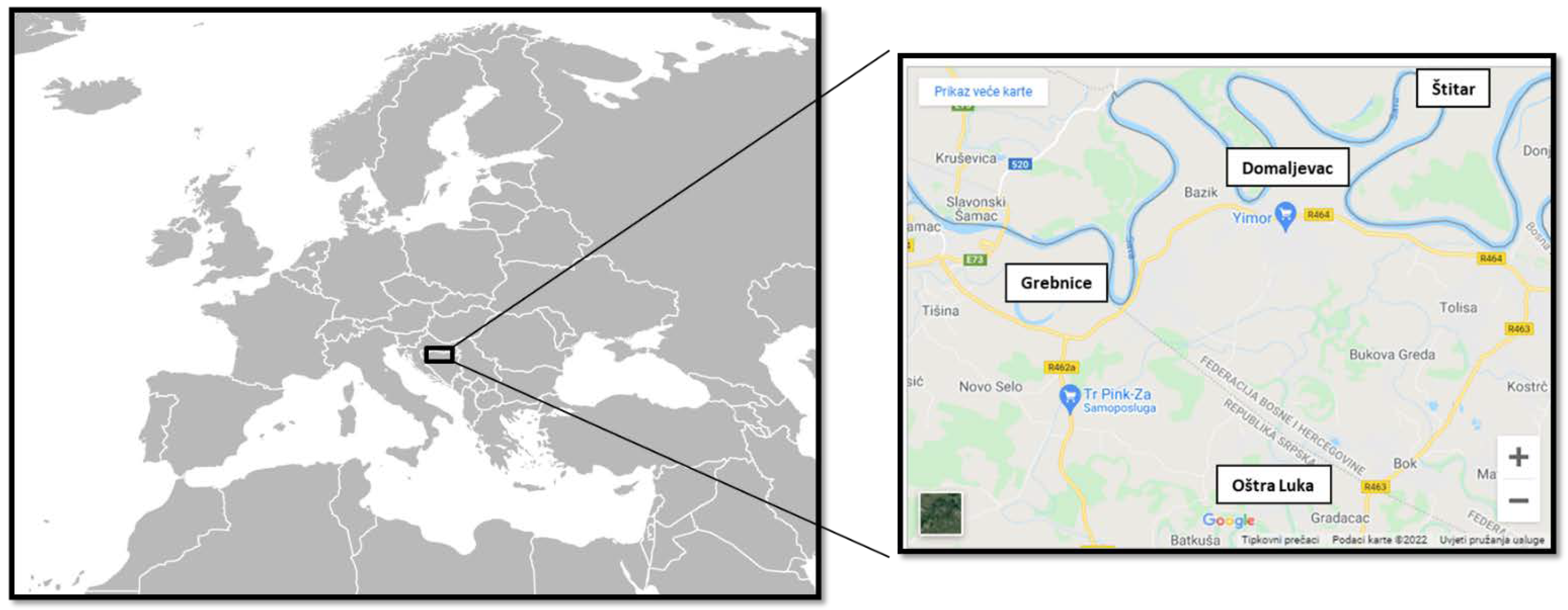

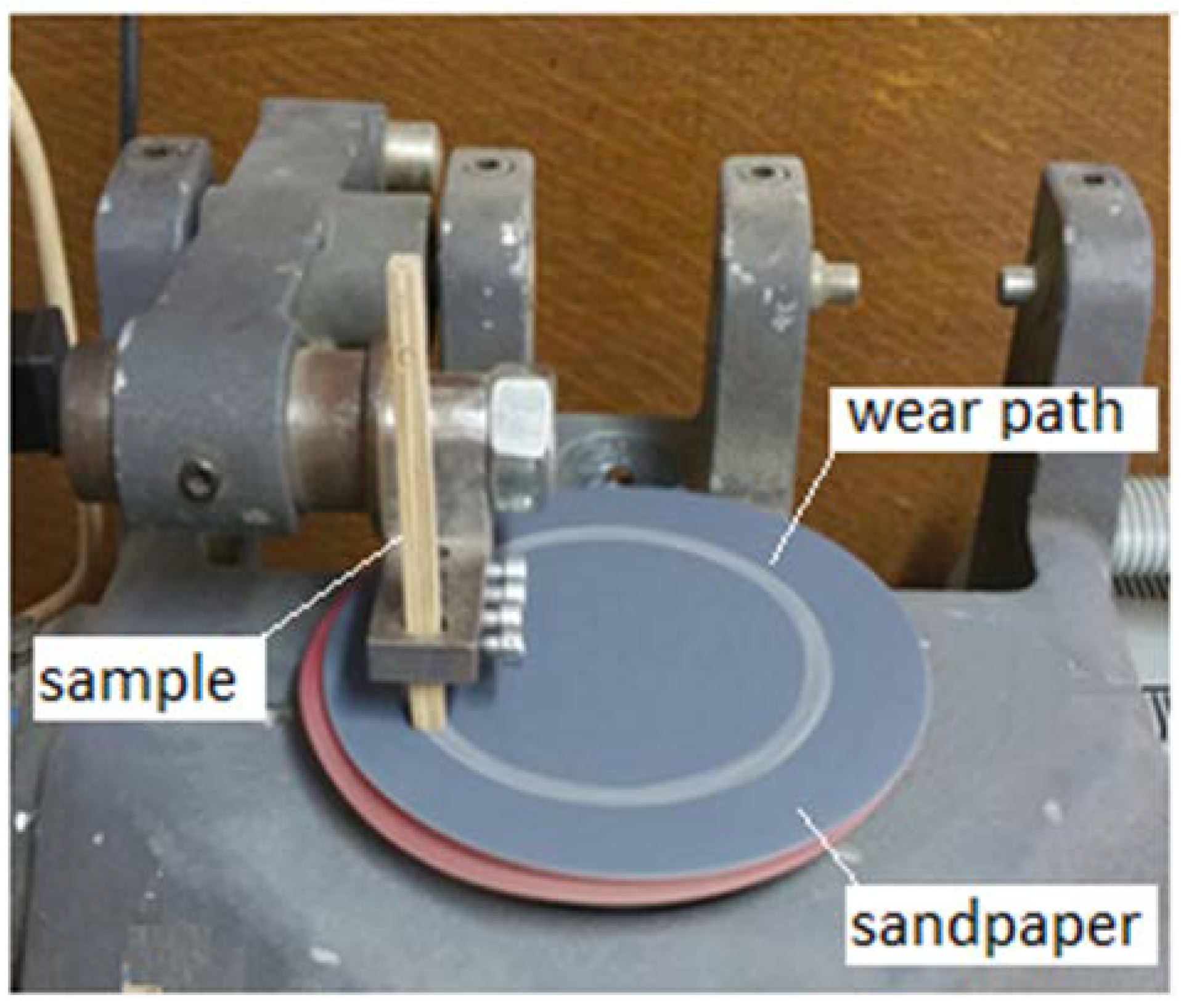
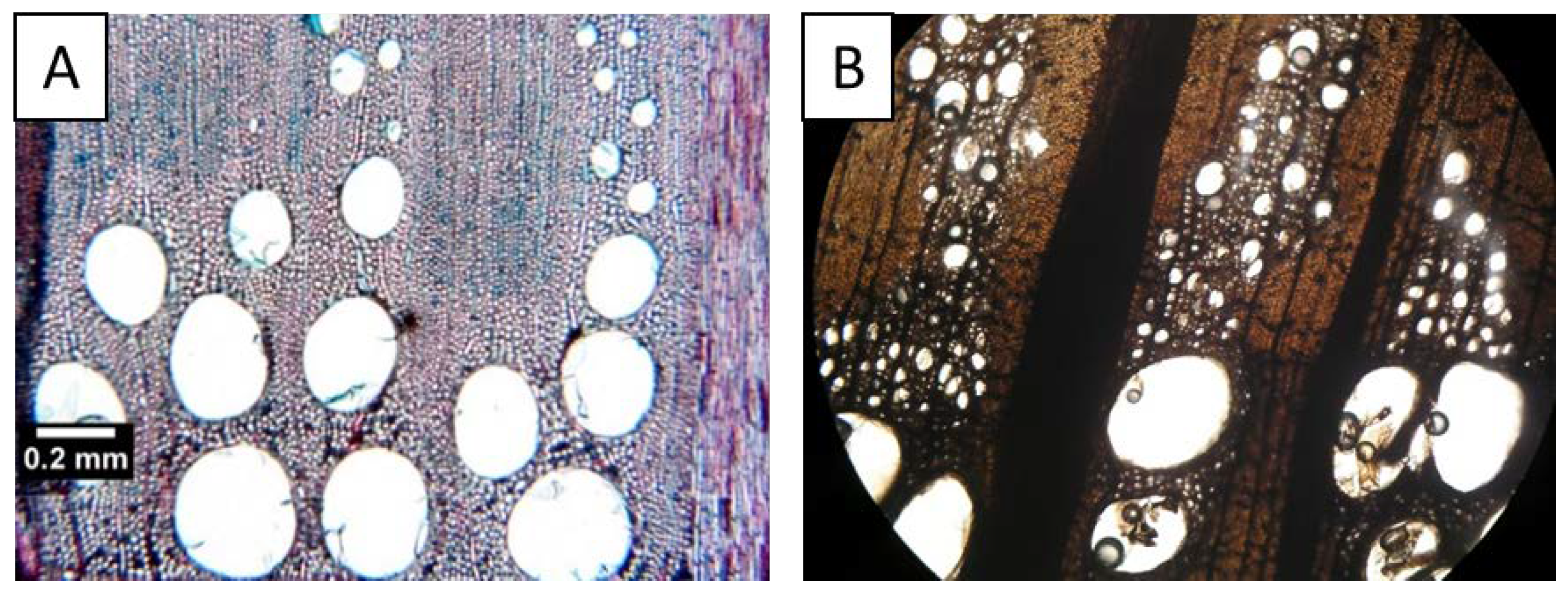
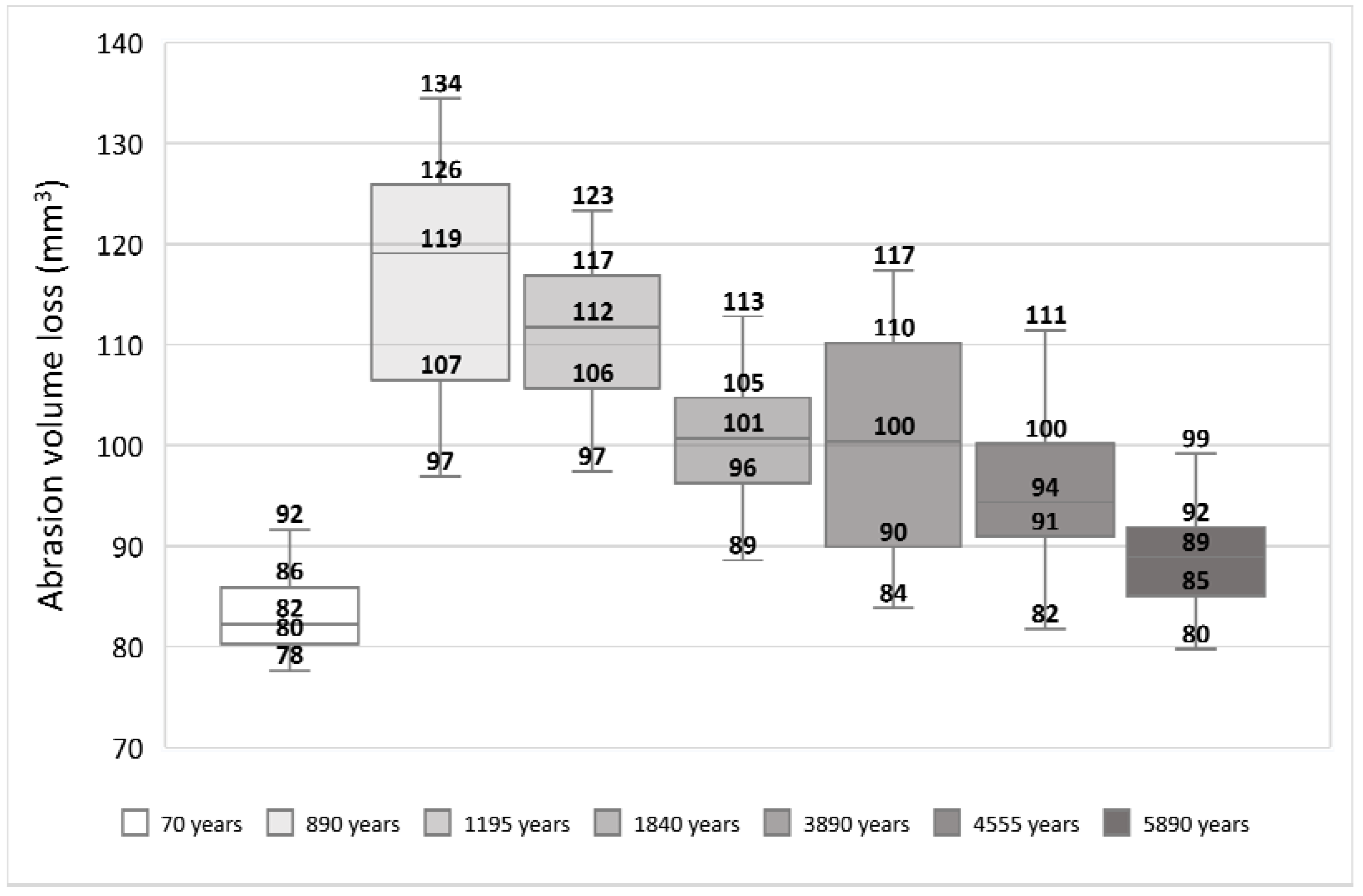
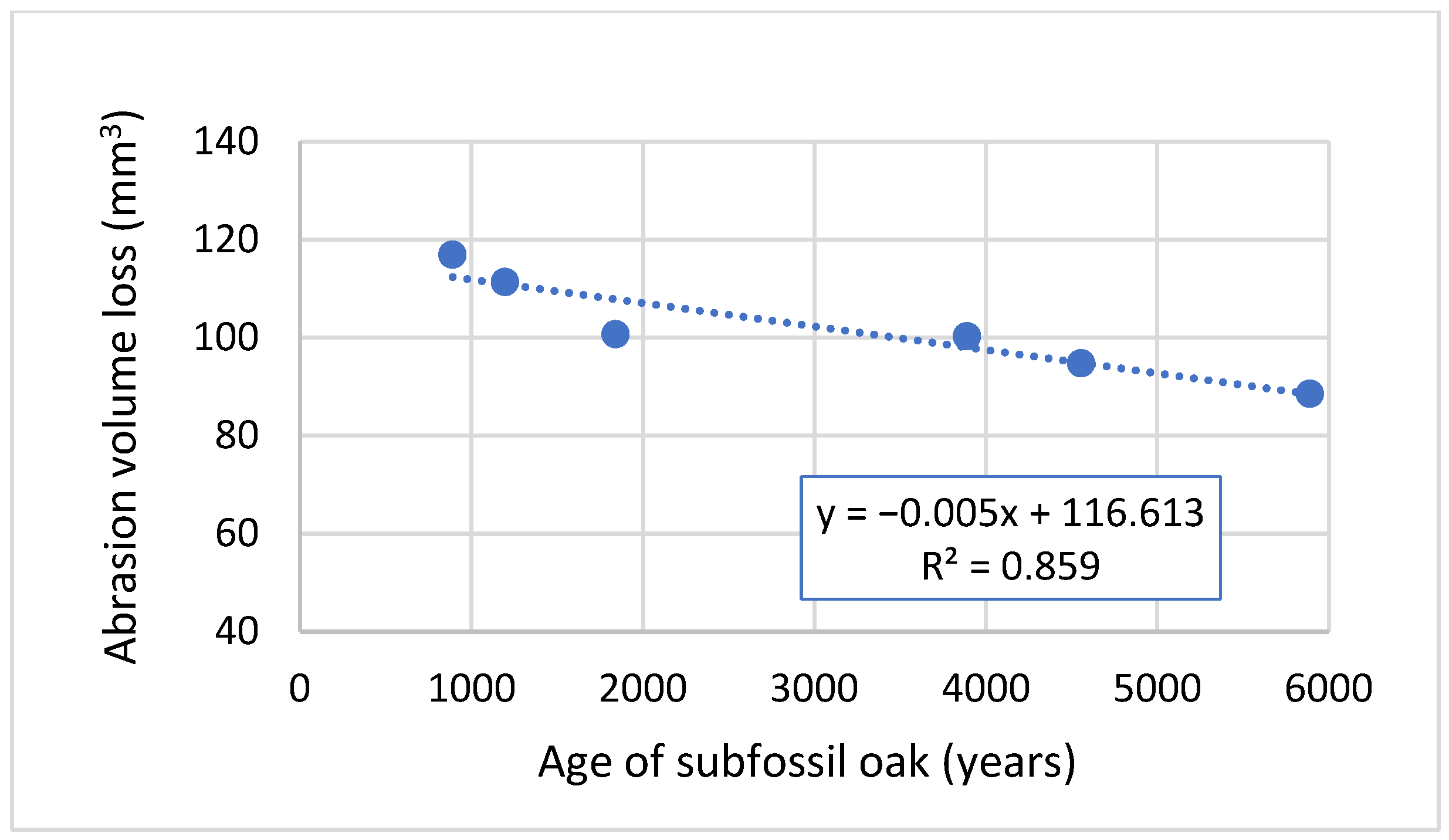

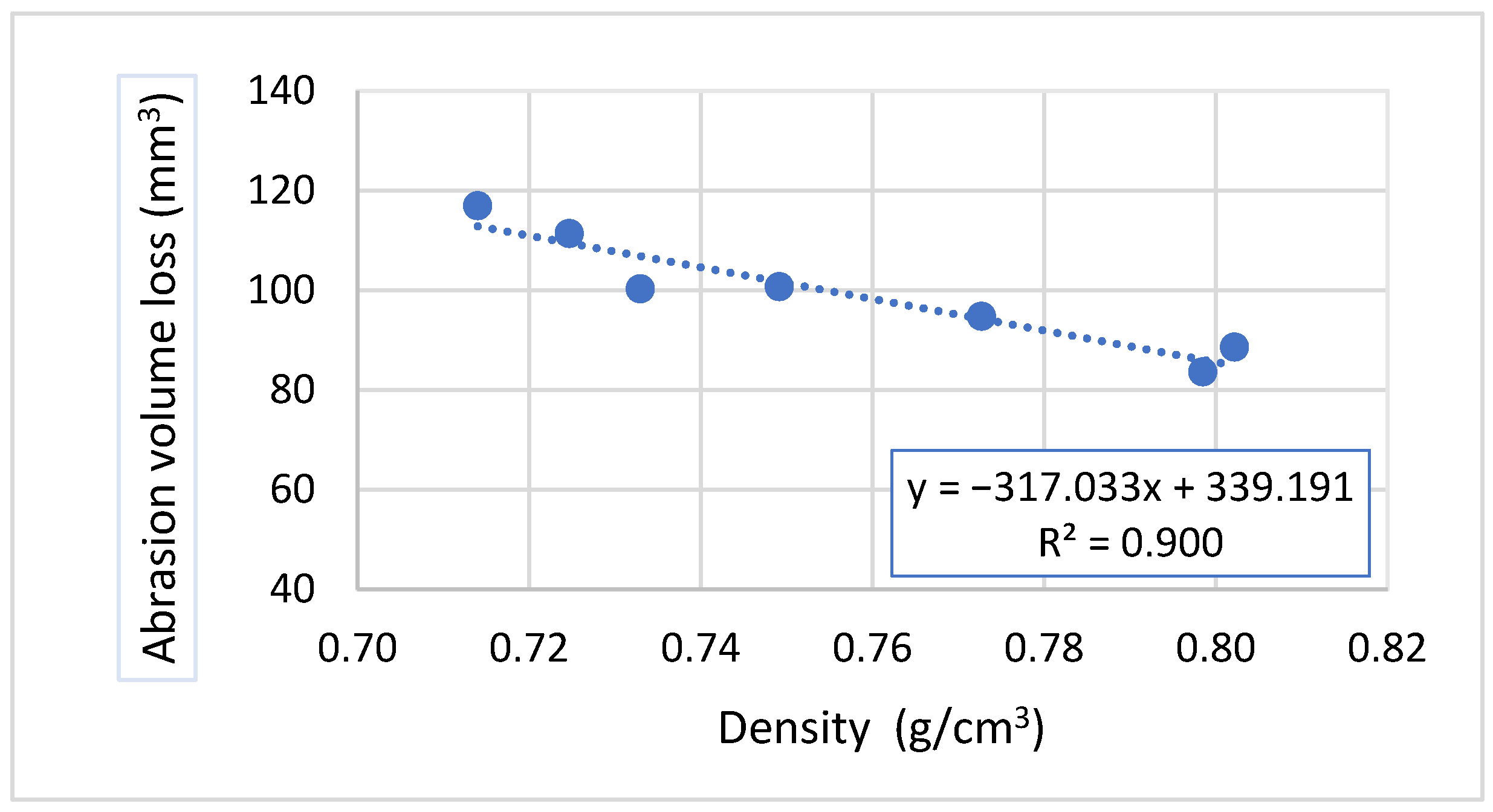
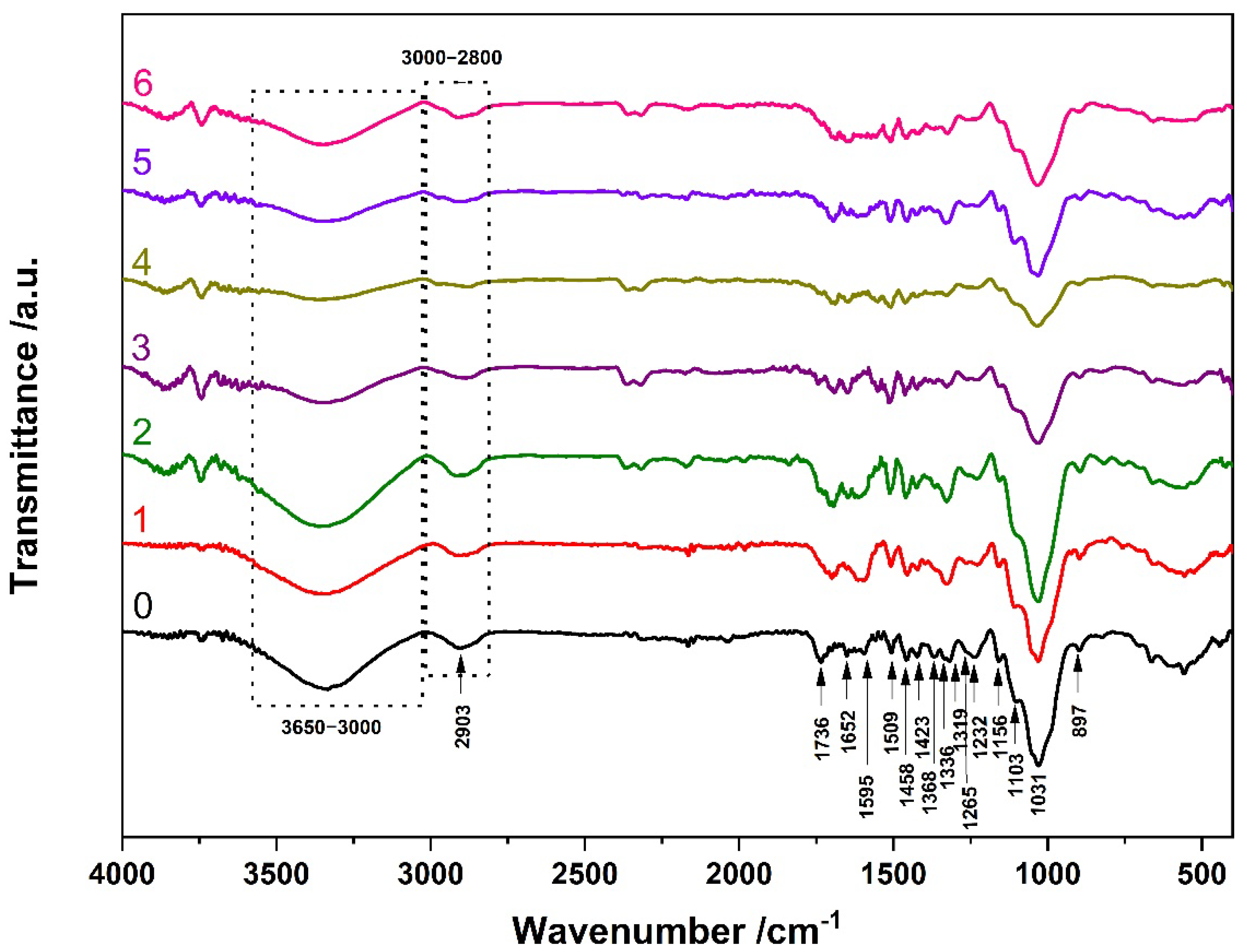

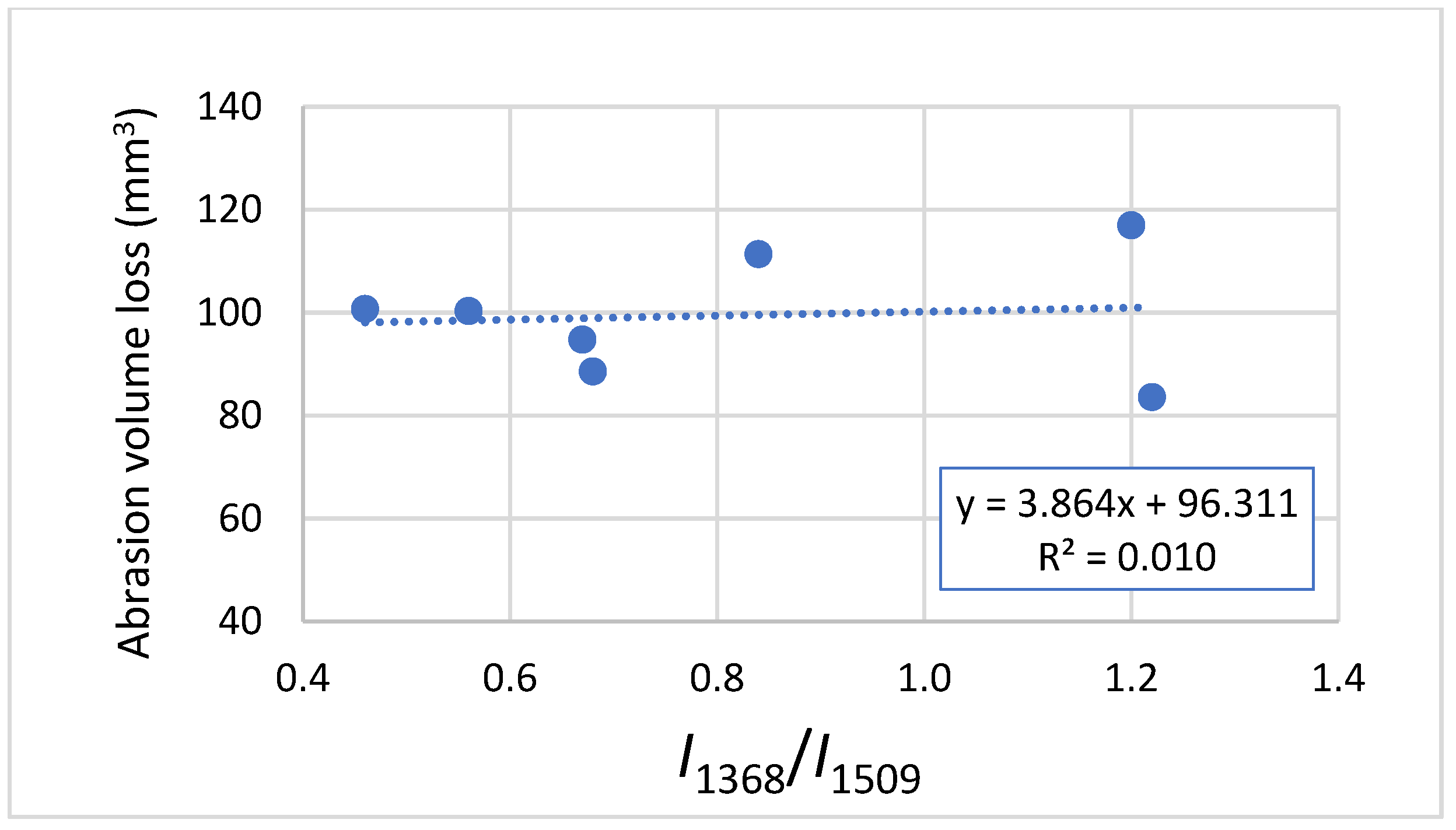


| ID Sample | Origin of Sample | Conventional 14C Age (BP)/Years |
|---|---|---|
| 1 | Grebnice/Domaljevac | 890 ± 50 |
| 2 | Grebnice/Domaljevac | 1195 ± 50 |
| 3 | Grebnice/Domaljevac | 1840 ± 55 |
| 4 | Grebnice/Domaljevac | 3890 ± 65 |
| 5 | Grebnice/Domaljevac | 4555 ± 65 |
| 6 | Oštra Luka | 5890 ± 115 |
| SAMPLE ID | Δm12 (g) | ρ12 (g/cm3) | I1368/I1509 | I1319/I1336 | |||||||
|---|---|---|---|---|---|---|---|---|---|---|---|
| Xp | SD | Min | Max | Xp | SD | Min | Max | CV | |||
| 0 | 0.067 | 0.003 | 0.062 | 0.070 | 0.798 | 0.028 | 0.760 | 0.833 | 3.5 | 1.22 | 1.08 |
| 1 | 0.082 | 0.007 | 0.072 | 0.094 | 0.714 | 0.022 | 0.685 | 0.742 | 2.9 | 1.20 | 0.88 |
| 2 | 0.081 | 0.004 | 0.077 | 0.085 | 0.725 | 0.049 | 0.653 | 0.794 | 6.7 | 0.84 | 0.83 |
| 3 | 0.075 | 0.004 | 0.071 | 0.083 | 0.749 | 0.025 | 0.706 | 0.803 | 3.3 | 0.46 | 0.85 |
| 4 | 0.073 | 0.005 | 0.064 | 0.080 | 0.733 | 0.064 | 0.652 | 0.821 | 8.7 | 0.56 | 0.82 |
| 5 | 0.073 | 0.006 | 0.066 | 0.084 | 0.773 | 0.026 | 0.729 | 0.802 | 3.4 | 0.67 | 0.94 |
| 6 | 0.071 | 0.005 | 0.065 | 0.079 | 0.802 | 0.013 | 0.780 | 0.821 | 1.6 | 0.68 | 0.84 |
Publisher’s Note: MDPI stays neutral with regard to jurisdictional claims in published maps and institutional affiliations. |
© 2022 by the authors. Licensee MDPI, Basel, Switzerland. This article is an open access article distributed under the terms and conditions of the Creative Commons Attribution (CC BY) license (https://creativecommons.org/licenses/by/4.0/).
Share and Cite
Rede, V.; Essert, S.; Kocijan, M.; Dubravac, T. Influence of Ageing on Abrasion Volume Loss, Density, and Structural Components of Subfossil Oak. Appl. Sci. 2022, 12, 1814. https://doi.org/10.3390/app12041814
Rede V, Essert S, Kocijan M, Dubravac T. Influence of Ageing on Abrasion Volume Loss, Density, and Structural Components of Subfossil Oak. Applied Sciences. 2022; 12(4):1814. https://doi.org/10.3390/app12041814
Chicago/Turabian StyleRede, Vera, Sara Essert, Martina Kocijan, and Tomislav Dubravac. 2022. "Influence of Ageing on Abrasion Volume Loss, Density, and Structural Components of Subfossil Oak" Applied Sciences 12, no. 4: 1814. https://doi.org/10.3390/app12041814
APA StyleRede, V., Essert, S., Kocijan, M., & Dubravac, T. (2022). Influence of Ageing on Abrasion Volume Loss, Density, and Structural Components of Subfossil Oak. Applied Sciences, 12(4), 1814. https://doi.org/10.3390/app12041814








